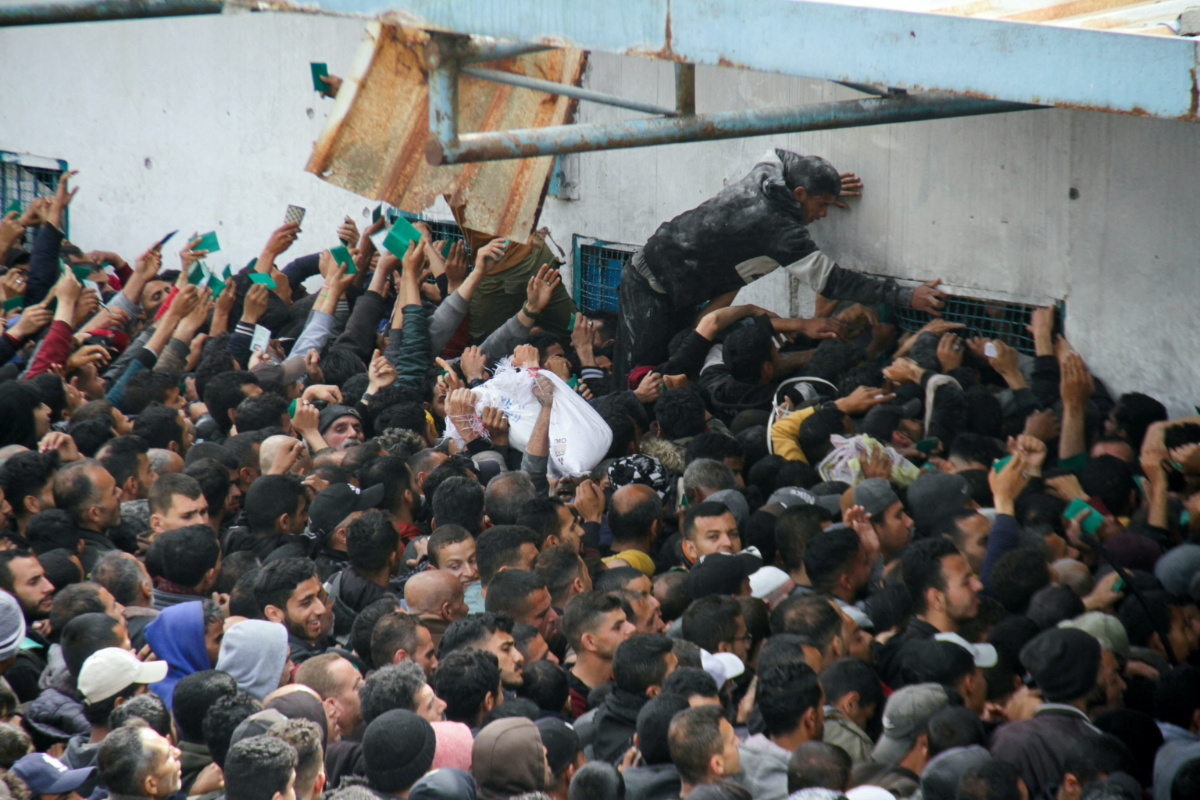
In an in-depth report, JOHN DAVISON, MICHELLE NICHOLS, EMMA FARGE, EMILY ROSE and FARAH SAAFAN, of Reuters, detail the arduous process of getting aid into Gaza…
Cairo, Egypt
Reuters
In mid-March, a line of trucks stretched for three kilometres along a desert road near a crossing point from Israel into the Gaza Strip. On the same day, another line of trucks, some 1.5 kilometres long, sometimes two or three across, was backed up near a crossing from Egypt into Gaza.
The trucks were filled with aid, much of it food, for the more than 2 million Palestinians in the war-ravaged enclave. About 50 kilometres from Gaza, more aid trucks – some 2,400 in total – were sitting idle this month in the Egyptian city of Al Arish, according to an Egyptian Red Crescent official.

Palestinians gather to receive aid outside an UNRWA warehouse in Gaza City, on 18th March, 2024. PICTURE: Reuters/Mahmoud Issa
These motionless food-filled trucks, the main lifeline for Gazans, are at the heart of the escalating humanitarian crisis gripping the enclave. More than five months into Israel’s war with Hamas, a report by a global authority on food security has warned that famine is imminent in parts of Gaza, as more than three-quarters of the population have been forced from their homes and swathes of the territory are in ruins.
Galvanised by reports and images of starving children, the international community, led by the United States, has been pressuring Israel to facilitate the transfer of more aid into Gaza. Washington has airdropped food into the Mediterranean enclave and recently announced it would build a pier off the Gaza coast to help ferry in more aid.
UN officials have accused Israel of blocking humanitarian supplies to Gaza. The European Union’s foreign policy chief alleged Israel was using starvation as a “weapon of war”. And aid agency officials say Israeli red tape is slowing the flow of trucks carrying food supplies.
Israeli officials reject these accusations and say they have increased aid access to Gaza. Israel isn’t responsible for delays in aid getting into Gaza, they say, and the delivery of aid once inside the territory is the responsibility of the UN and humanitarian agencies. Israel has also accused Hamas of stealing aid.
Reuters interviewed more than two dozen people, including humanitarian workers, Israeli military officials and truck drivers, in tracing the tortuous route that aid takes into Gaza in an effort to identify the chokepoints and reasons for delays of supplies. Reuters also reviewed UN and Israeli military statistics on aid shipments, as well as satellite images of the border crossing areas, which revealed the long lines of trucks.
Before the aid shipments enter Gaza, they undergo a series of Israeli checks, and a shipment approved at one stage of the process can later be rejected, according to 18 aid workers and UN officials involved in the aid effort. At one crossing from Israel into Gaza, goods are twice loaded off trucks and then reloaded onto other trucks that then carry the aid to warehouses in Gaza. The aid delivery process can also be complicated by competing international demands, with some countries wanting their contributions to be prioritized.
Aid that does make it into Gaza can be ransacked by desperate civilians, sometimes fall prey to armed gangs, or get held up by Israeli army checkpoints. Half the warehouses storing aid in Gaza are no longer operational after having been hit in the fighting.
“It’s upsetting watching these aid trucks go nowhere and vast humanitarian supplies sit in warehouses when you think about what’s happening, right now, to the people who need them,” said Paolo Pezzati, an Oxfam worker who recently visited the queue of aid trucks near the Egypt-Gaza border.
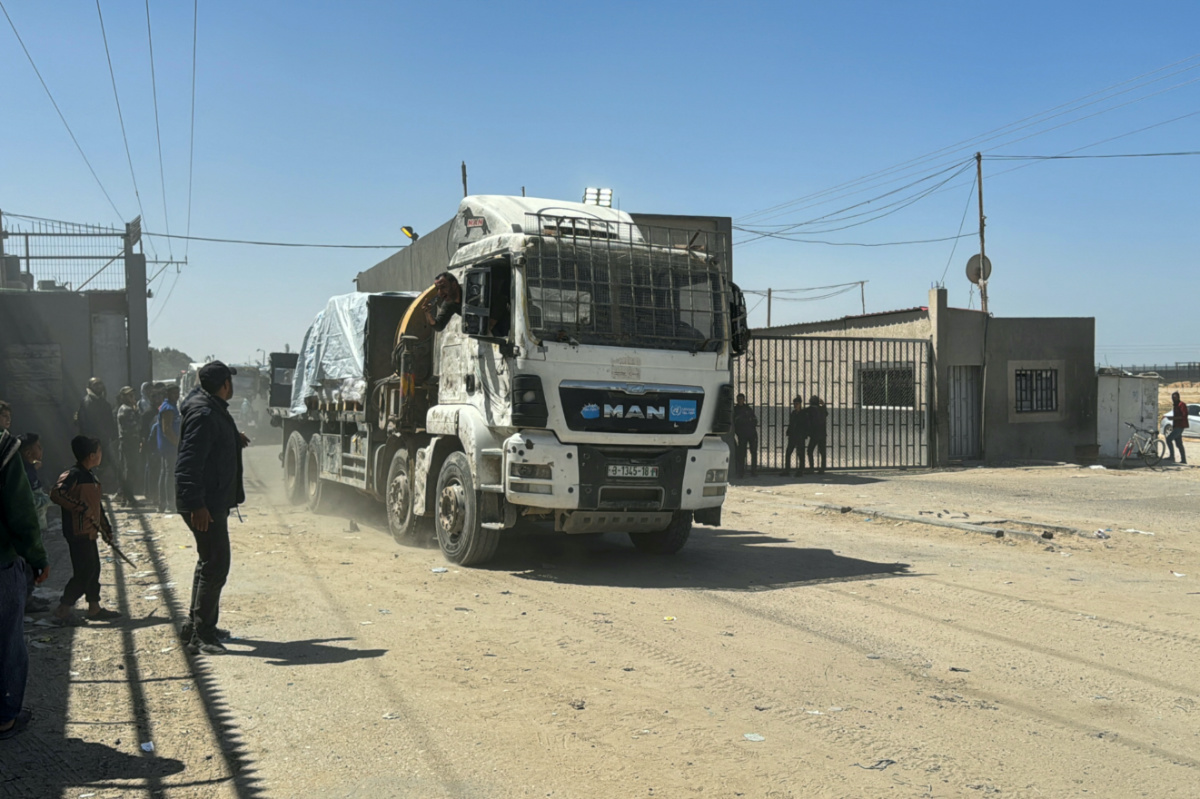
A truck carrying aid enters Gaza via Kerem Shalom crossing, amid the ongoing conflict between Israel and Hamas, in Rafah in the southern Gaza Strip, on 21st March, 2024. PICTURE: Reuters/Bassam Masoud/File photo
Before the war began, an average of 200 trucks carrying aid entered Gaza each day, according to UN figures. A further 300 trucks laden with commercial imports, including food, agricultural supplies and industrial materials, also entered each day via Israel. Since the start of the war, an average of around 100 trucks have entered Gaza daily, according to a review of UN and Israeli military statistics on aid shipments.
While the trucks struggle to get into Gaza, the need for aid has risen dramatically, both because of the vast number of displaced people and the devastation of key infrastructure in Israel’s assault. This includes the destruction of bakeries, markets, and farmland whose crops met some of Gaza’s food needs.
“Previous wars weren’t like this,” said Alaa al-Atar, a municipal official, referring to conflicts in Gaza. “There wasn’t the destruction of all sources of subsistence – homes, farmland, infrastructure. There’s nothing left to survive on, just aid,” said Atar, who was displaced from the north to the south of Gaza early in the war.
To meet its minimum needs, aid agencies and U.N. officials say Gaza currently requires 500 to 600 trucks a day, including humanitarian aid and the commercial supplies that were coming in before the war. That’s about four times the number of trucks getting in now.
In March there has been an uptick, with an average of 150 trucks entering Gaza each day.
Some deliveries are being made by international air drops and via sea, but they aren’t making up for shortfalls on the land routes. In the first three weeks of March, the equivalent of some 50 truckloads of aid was airdropped and brought in by sea, a Reuters tally based on Israeli military statistics showed.
The recent food security report, known as the Integrated Food Security Phase Classification (IPC), found that a lack of aid means almost all households in Gaza are skipping meals every day and adults are cutting back on meals so their children can eat. The situation is particularly dire in northern Gaza, it said, where in nearly two-thirds of households, “people went entire days and nights without eating at least 10 times in the last 30 days.”
The war was triggered by a Hamas-led attack on communities in southern Israel on 7th October that killed 1,200 people and resulted in more than 250 being taken hostage, according to Israel. Since then, Israel’s assault on Gaza has killed more than 31,000 people, according to Gaza health authorities.
A senior Hamas official said Israel is responsible for the inadequate aid flows. The “biggest threat” to the distribution of aid is Israel’s ongoing attacks in Gaza, Hamas official Bassem Naim told Reuters. “The biggest obstacle to getting the aid to the people who need it is the continued gunfire and the continued targeting of aid and those who are handling it,” he said.
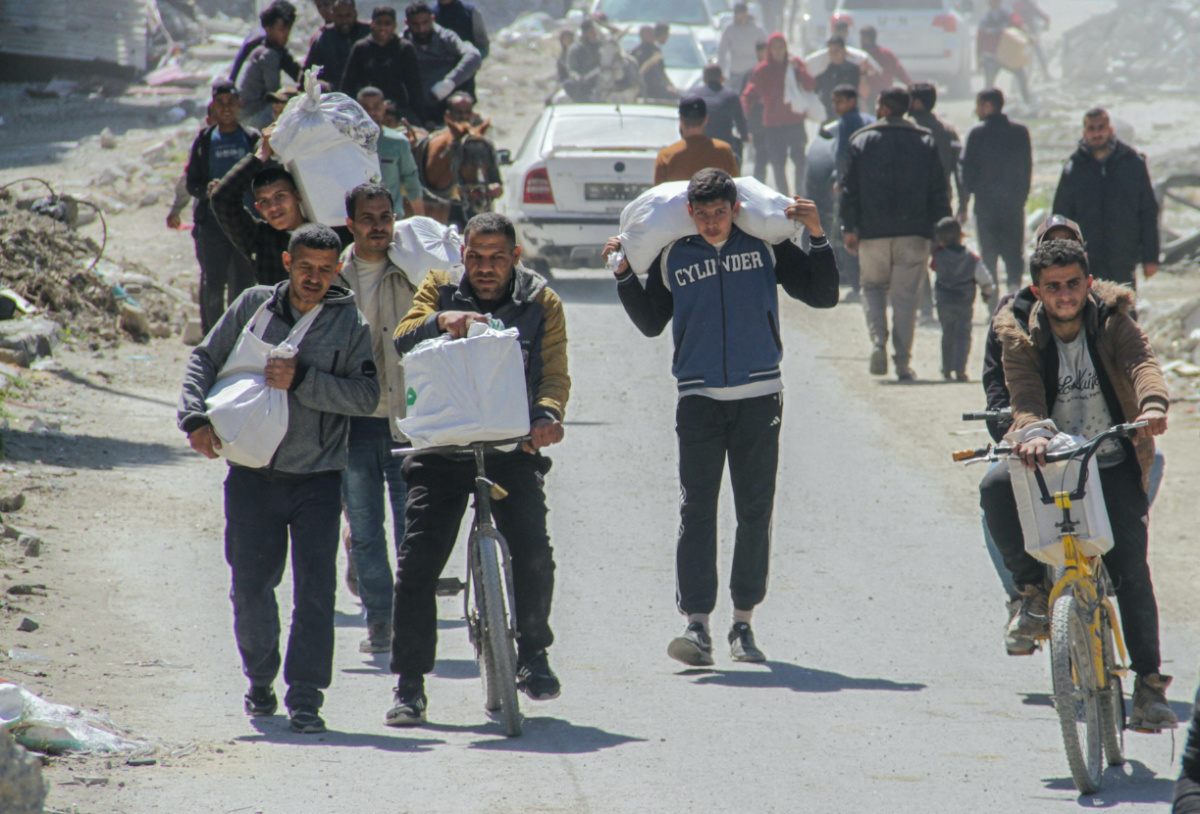
Palestinians carry aid unloaded from a truck, amid the ongoing conflict between Israel and Hamas, in Gaza City, on 23rd March, 2024. PICTURE: Reuters/Mahmoud Issa/ File photo
Before some of the aid begins its journey to Gaza, it is flown to Cairo or shipped by sea to Port Said, which borders Egypt’s Sinai Peninsula, about 150 kms to the west of Al Arish. From there, it is trucked to the city of Al Arish, on the Mediterranean coast. Some aid is also flown directly to the Egyptian city.
Once in Cairo or Al Arish, the aid undergoes its first check. International agencies submit a detailed inventory of each shipment to the Israeli military via the UN for clearance. Israel has long banned “dual use” items that it says could be used by Hamas to make weapons.
Of 153 requests made to the Israeli authorities for goods to enter Gaza between 11th January and 15th March, 100 were cleared, 15 were rejected outright and another 38 were pending, the United Nations Office for the Coordination of Humanitarian Affairs told Reuters. UN officials didn’t specify whether a request referred to a specific number of trucks or volume of aid. It takes almost a month on average to get a response, according to minutes of a meeting of aid agencies seen by Reuters.
The Israeli military says it approves almost 99 per cent of the Gaza-bound trucks it inspects and that once the goods are inside the enclave, it is the responsibility of the international aid organisations to distribute it. The inspection process “isn’t the impediment” to aid “getting into the Gaza Strip,” said Shimon Freedman, a spokesman for COGAT, the Israeli military branch that handles aid transfers.
We rely on our readers to fund Sight's work - become a financial supporter today!
For more information, head to our Subscriber's page.
Diplomatic wrangling by countries donating aid can also create snarls in the delivery process. UN officials told Reuters that because aid comes not only from international agencies but also directly from individual donor countries, the process of deciding which trucks go to the front of the queue can be thorny even before they depart Al Arish.
The Egyptian Red Crescent official said donor countries “drop off aid in Al Arish or at Al Arish airport and walk away and say, ‘We gave out aid to Gaza.’” It is the Red Crescent and Egyptian authorities who then bear the responsibility of getting the aid to Gaza, he said.
From Al Arish, the trucks make the 50-kilometre journey to the Rafah crossing point on the Egypt-Gaza border.
Next stop: Israel’s truck-scanning centres.
Once they reach the Rafah crossing, some trucks are then required to drive along the Egypt-Israel border for 40 kilometres to an inspection facility on the Israeli side called Nitzana. Here the goods are physically checked by Israeli soldiers who use scanning machines and sniffer dogs, according to UN and other aid agency staff.
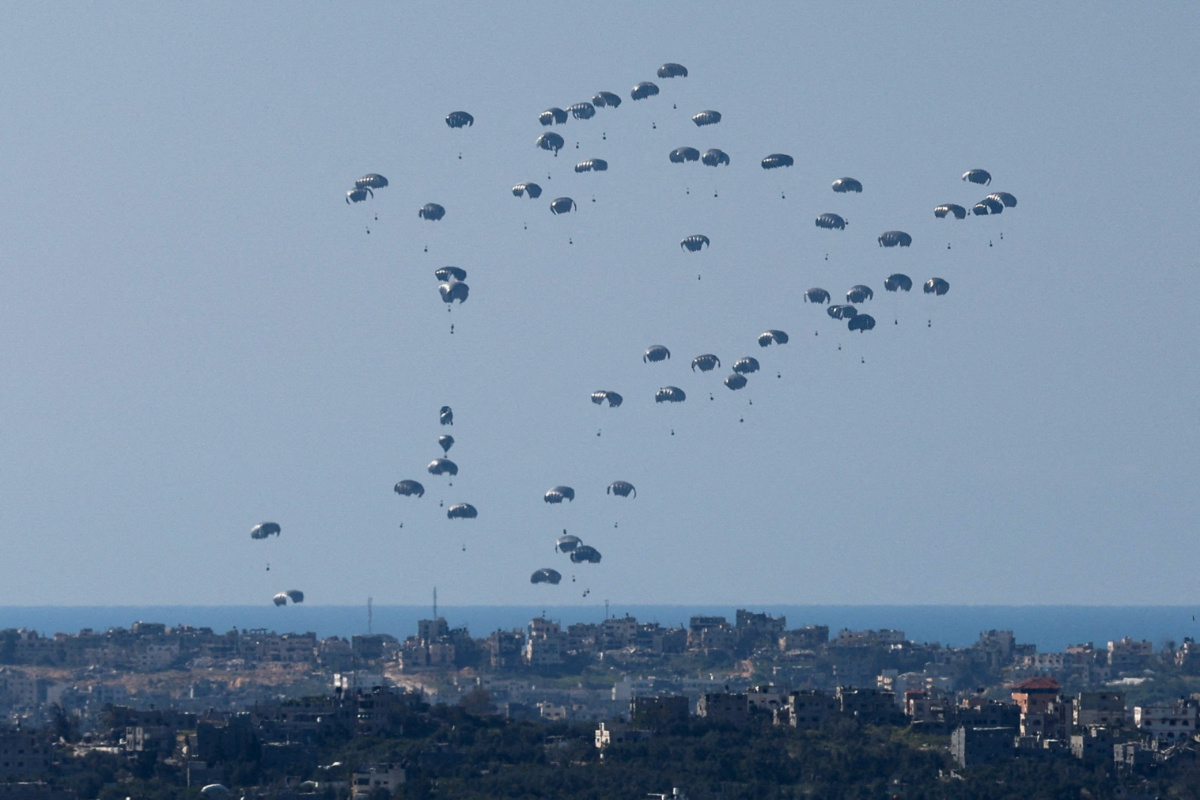
Packages fall towards northern Gaza, after being dropped from a military aircraft, amid the ongoing conflict between Israel and the Palestinian group Hamas, as seen from Israel’s border with Gaza, in southern Israel, on 11th March, 2024. PICTURE: Reuters/Ronen Zvulun/File photo
Some items get rejected during the physical inspection, in particular ones Israel believes could be used by Hamas and other armed groups for military purposes. Some shipments carrying dual-use items are sent back to Al Arish. The same item that is let through one day, can be rejected on another day, UN officials and aid workers said.
UN agencies say solar panels, metal tent poles, oxygen tanks, generators and water purification equipment are among the items the military has rejected.
Pezzati, the Oxfam worker, said he saw a warehouse in Al Arish in early March that was filled with items banned by Israel. “There were crutches, camping toilets, hygiene kits, disinfectants for doctors, for surgery,” he said.
COGAT’S Freedman said there is a publicized list of what constitutes dual-use items, but there isn’t a “blanket ban” on these goods. If Israeli authorities “understand what exactly it is necessary for, we can coordinate it,” he said. But Israel wants to be sure that goods aren’t going to be “used by Hamas for terrorist activities,” he said.
Israel’s inspections, Freedman said, aren’t the reason for any backlog in aid. “We have the capacity to inspect more humanitarian aid than the international organisations can distribute,” he said.
The Israeli military says it can scan a total of 44 trucks an hour at Nitzana and at a crossing from Israel into Gaza where aid trucks are inspected, at Kerem Shalom. But aid agency officials say the actual number scanned is fewer. The military declined to say how many hours Nitzana and Kerem Shalom are open each day.
Once the trucks pass inspection at Nitzana, they make the 40 kilometre journey back to Rafah, where they wait to cross into Gaza.
In late January, groups of Israelis, including friends and relatives of the more than 130 people still being held hostage by Hamas, began protesting against the delivery of aid to Gaza. Between late January and early March, the protests effectively shut down either Nitzana or Kerem Shalom for a total of 16 days, according to aid agencies.
At the Kerem Shalom crossing, goods are unloaded from the scanned trucks and reloaded onto trucks that have been vetted by the Israeli army, according to UN and aid agency workers. These “sanitised” trucks then make a one kilometre journey to a warehouse inside Gaza where the aid is again offloaded. The goods are then placed on trucks driven by Palestinians and taken to mostly UN-run warehouses in Rafah.
Under growing international pressure, Israel earlier this month initiated a new route for the delivery of aid directly to northern Gaza, known as the 96th gate. By March 20, COGAT said at least 86 international aid trucks had entered via the new crossing.
“There is a sufficient amount of food entering Gaza every day,” said Colonel Moshe Tetro, a COGAT official overseeing Gaza.
The new route was initiated “as part of a pilot in order to prevent Hamas from taking over the aid,” COGAT said in a post on social media site X. Freedman, though, said he didn’t have “specific evidence” he could share about Hamas pilfering aid.
Hamas official Naim rejected the accusation that the group was stealing aid. “We have been cooperating and are cooperating with every single state and humanitarian organisation so that the aid reaches people in dire need,” he said.
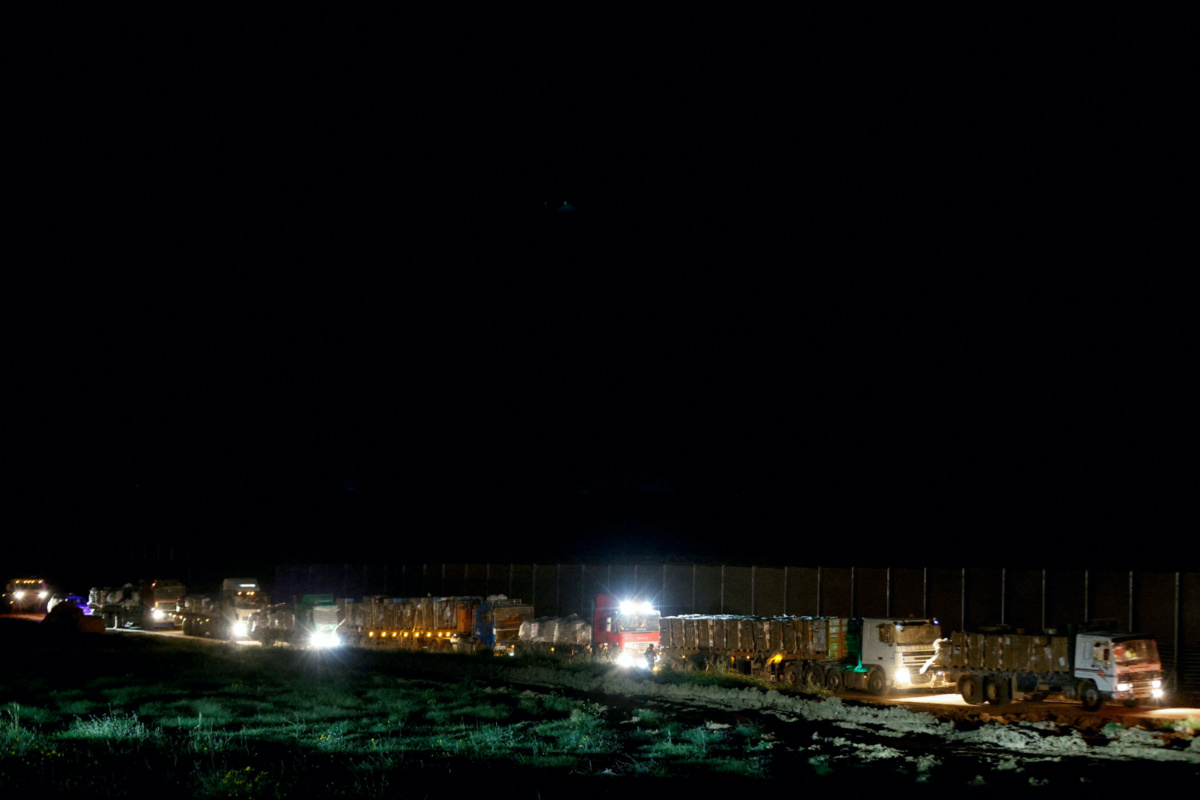
Aid trucks carrying humanitarian supplies are parked by the border fence before they enter Gaza through Gate 96, a newly opened entry point allowing quicker access into northern Gaza, in Israel, on 21st March, 2024. PICTURE: Reuters/Amir Cohen/File photo
Once inside Gaza, the aid shipments face more challenges.
Several convoys have been attacked on the stretch of road from Kerem Shalom to Gaza warehouses by people carrying crude weapons such as axes and box-cutters, according to UN officials and truck drivers. Deeper inside Gaza, others have been swarmed by crowds of people desperate for food.
In an incident that galvanised aid efforts, more than 100 people were killed in late February when a crowd descended on an aid convoy organized by Israel.
Security for food convoys traveling the short distance from the crossing points to warehouses in Rafah also deteriorated after several strikes by the Israeli military killed at least eight policemen in Gaza, according to UN officials. Israel says all police are members of Hamas.
“Whether they’re Hamas or not I don’t know, but they were doing a job for us in terms of crowd control,” said Jamie McGoldrick, a senior UN official. “The police are less willing to do that now.”
Aid agencies mostly now negotiate their own security with local communities, McGoldrick said.
Reuters reported recently that armed and masked men from an array of clans and factions in Gaza had begun providing security to aid convoys.
Police officers in Gaza “are Hamas, they are part of the Hamas terrorist organisation,” COGAT’s Freedman said. Israel doesn’t target humanitarian convoys, “we try to assist them, but Hamas is our enemy.”
Storing aid in Gaza has also become a problem. Warehouses have been damaged by the fighting and occasionally looted. Of the 43 warehouses in Gaza that were operational before the war, only 22 are now working, according to the Logistics Cluster, a UN-run logistics facilitator for aid agencies.
In mid-March, an Israeli airstrike hit a UN food distribution centre in southern Gaza, killing several people. Israel said it killed a Hamas commander in the attack. Hamas said the man targeted by Israel was a member of its police force.
From the warehouses, aid is delivered to southern Gaza, where the majority of the population is now located.
Making deliveries to northern Gaza is more fraught.
Roads to the north have been bombed by Israel and there are delays as trucks are held up or denied access at Israeli army checkpoints, say UN and other aid agency officials. Aid convoys are also often looted before reaching their destination by crowds of people desperate for food, UN officials said.
UN officials told Reuters that humanitarian agencies had made 158 requests to the Israeli military to deliver aid to northern Gaza from the beginning of the war to March 14. Of those, the military denied 57, they said.
COGAT’s Freedman said some requests to move aid inside Gaza have been rejected because aid agencies didn’t coordinate sufficiently with Israel.
“They weren’t able to tell us exactly where that aid was going,” he said. “And if we don’t know where it’s going to, we don’t know it’s not going to end up in the hands of Hamas.”
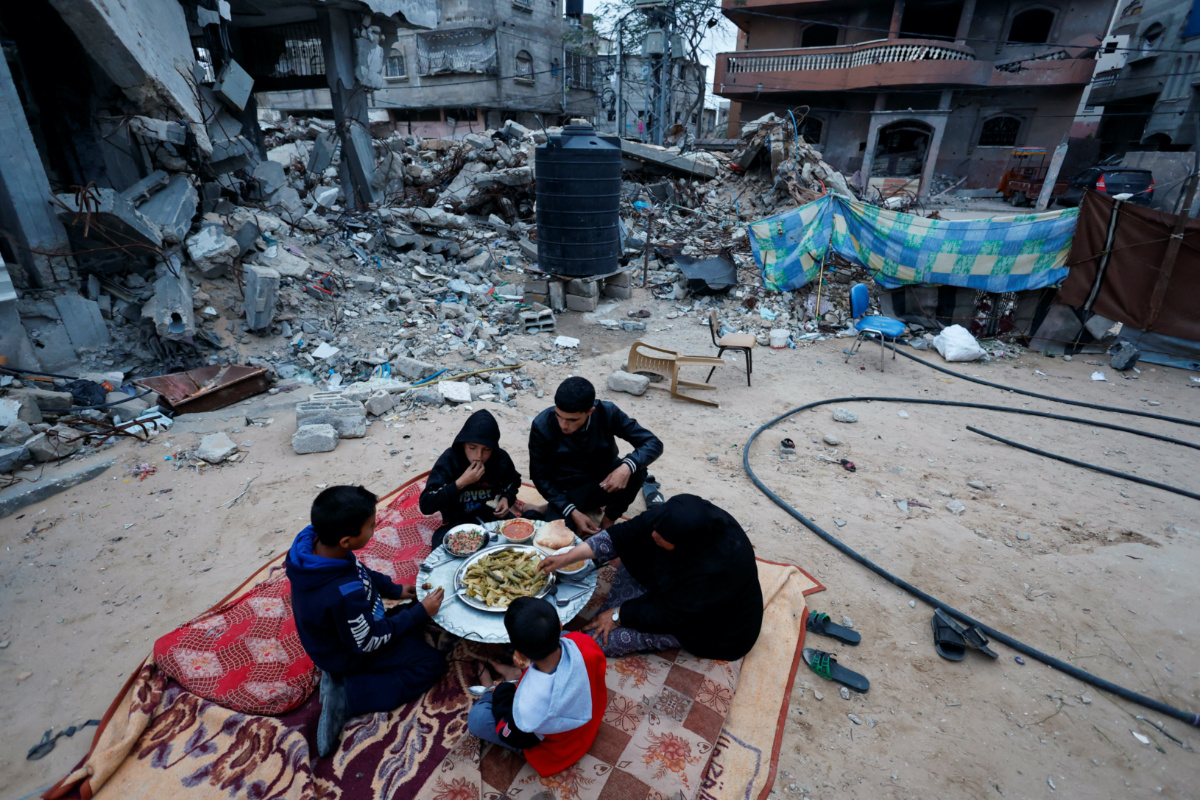
Members of Palestinian Abu Ghouta family eat their iftar meal as they break their fast near the rubble of their destroyed house during the holy month of Ramadan, amid the ongoing conflict between Israel and Hamas, in Rafah in the southern Gaza Strip, on 21st March, 2024. PICTURE: Reuters/Mohammed Salem/File photo
In southern Gaza, residents are desperately waiting for aid.
“People have nothing to eat at all, nor do they have a place to stay, or a refuge,” said Suleiman al-Jaal, a local truck driver who said he has been attacked transporting aid in Gaza. “This is not a life. No matter how much aid they bring in, it’s not enough.”
– Additional reporting by AIDAN LEWIS, NIDAL AL-MUGHRABI, JAMES MACKENZIE, and GABRIELLE TÉTRAULT FARBER





